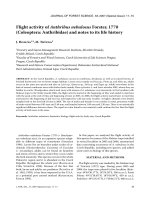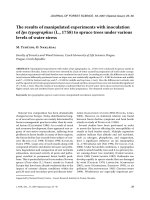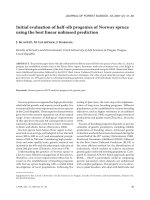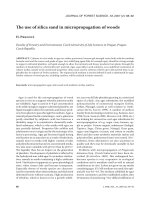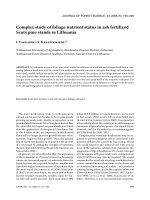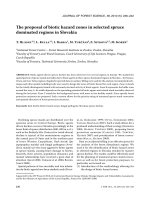Báo cáo lâm nghiệp: " Flight activity of Anthribus nebulosus Forster, 1770 (Coleoptera: Anthribidae) and notes to its life history" potx
Bạn đang xem bản rút gọn của tài liệu. Xem và tải ngay bản đầy đủ của tài liệu tại đây (222.61 KB, 5 trang )
J. FOR. SCI., 53, 2007 (Special Issue): 11–15 11
JOURNAL OF FOREST SCIENCE, 53, 2007 (Special Issue): 11–15
Anthribus nebulosus Forster 1770 (= Brachytar-
sus nebulosus auct.) is an expansive species adapt-
able to different types of ecosystems (S
1996). Larvae live on branches under scales of co-
chineals (Sternorrhyncha: Coccinea) of Coccidae
(= Lecaniidae), adults can be found on branches
and stems of trees and in winter they occur under
the bark massively. is species occurs in the whole
Palearctic region and it is abundant in the Czech
Republic throughout the whole year (B
1956; S 1990). Because of the fact that
both, larvae and adults, are predators (P et
al. 1962, 1999), it has been imported to the U.S.A.
as a potential pest control method (K,
K 1983).
In this paper, we analyzed the flight activity of
this species by means of the Malaise traps installed
in several localities in 2005 and 2006, summarized
data concerning occurrence of A. nebulosus in the
Czech Republic, including tree species, and added
some notes to biology of this species.
MATERIAL AND METHODS
e flight activity was studied by the Malaise trap
of T (1972) type. During years 2005 and
2006, the traps were placed in five localities (Kyjo-
vice: 49°49'30.17''N, 18°3'4.38''E, 390 m a.s.l.; Pustá
Polom: 49°51'38.05''N, 18°0'16.99''E, 430 m a.s.l.;
Podvihov: 49°51'6.47''N, 17°58'46.72''E, 460 m a.s.l.;
Flight activity of Anthribus nebulosus Forster, 1770
(Coleoptera: Anthribidae) and notes to its life history
J. H
1,2
, M. T
3
1
Forestry and Game Management Research Institute, Jíloviště-Strnady,
Frýdek-Místek, Czech Republic
2
Faculty of Forestry and Wood Sciences, Czech University of Life Sciences Prague,
Prague, Czech Republic
3
Research and Nature Conservation Department, Bohemian Switzerland National
Park Administration, Krásná Lípa, Czech Republic
ABSTRACT: In the Czech Republic, A. nebulosus occurs in coniferous, deciduous as well as in mixed forests, in
lowland forests and even on forest-steppe habitats. Larvae occur mainly on Picea sp., Pinus sp. and Abies sp.; adults
occur on the same tree species and also on Larix sp., Quercus sp., Salix sp. and Fagus sp. Adults overwinter in the
bark of several coniferous trees with thicker bark (mainly Pinus sylvestris L. and Larix decidua Mill.) where they are
hidden in cracks. Woodpeckers attack such trees with masses of A. nebulosus very intensively. In five localities with
Malaise traps in the Nízký Jeseník Hills, the flight activity started at the beginning of May and ended in mid-June
with the peak at the end of May and beginning of June in 2005. In 2006, the flight activity started later in mid-May
and lasted to the beginning of July but was interrupted by cold and rainy weather. At higher altitudes were beetles
sampled only in the first half of June in 2006. e size of males and females is very similar. In total, pronotum width
of males varied between 0.85 mm and 2.40 mm, and females between 1.00 mm and 2.30 mm. ere is no statistically
significant difference between them. e equal sex ratio found in our material could confirm the fact that the flight
activity of both sexes is the same.
Keywords: Anthribus nebulosus; faunistics; biology; flight activity; body size; Czech Republic
12 J. FOR. SCI., 53, 2007 (Special Issue): 11–15
Lesní Albrechtice: 49°48'21.09''N, 17°53'4.78''E,
460 m a.s.l.; Skřipov: 49°48'39.08''N, 17°52'59.02''E,
480 m a.s.l.) in very young spruce forests (10 to
20-year-old) in the Nízký Jeseník Hills. In 2006,
one trap was placed in a closed older spruce (Picea
abies [L.] Karst.) forest (80–110-year-old) at the
distance of 50 m apart from the forest edge in the
locality Cikháj (49°39'43''N, 15°56'46''E; 780 m a.s.l.)
in the Českomoravská vrchovina Hills. e traps
were exposed from the beginning of April to the
end of October and were emptied every second or
third day in May, June and July. Numbers of caught
beetles were calculated in ten-day periods.
Faunistic data are presented as follows:
Bohemia
1
, Růžová env.
2
, Růžovský vrch Hill
3
,
5151d
4
, 20. VI. 2000
5
, Picea sp.
6
, 1 spec.
7
, M. Trýz-
na leg.
8
1
region;
2
village;
3
place;
4
grid mapping square (see P, M
1996);
5
date of collection;
6
tree species on which beetles were collected;
7
number of caught specimens;
8
collector.
All genitalia were dissected to determine both
sexes, however the 5
th
sternite might be also useful
as it is depressed in its middle part in male and con-
vex in female (S 1990). Pronotum width
was measured in the back part.
Statistical analyses were performed using soft-
ware Statistica 7.0.
RESULTS AND DISCUSSION
Distribution
Six species of the genus Anthribus Geoffroy, 1762
are known from the palearctic region (R
2004). e seventh species is reported from Brazil
but it is not congeneric. In the Czech Republic oc-
cur two species only, namely A. fasciatus (Foerster,
1770) and A. nebulosus. e Euroasian A. nebulosus
is a widespread species; it was recorded from the ma-
jority of European countries, North Russia, Near East
and from East Palaearctic. In 1970s, it was imported
from Hungary to the U.S.A. as a potential pest control
method in Virginia (
K, K 1983). It was
recently observed also in Connecticut, Massachusetts
and New York as a natural enemy of soft scale insects
(H, W 1991; V 1998).
In the Czech Republic represents A. nebulosus the
most abundant species of the family Anthribidae.
It occurs in miscellaneous types of habitats in the
whole country. In total, we summarized more than
one thousand faunistic data based on our collec-
tions as well as other collections (but only those data
where the tree species was mentioned are presented
below). It occurs at a wide range of altitudes. We
observed beetles of this species in the lowest places
of the Czech Republic, e.g. 150 m a.s.l. (Bohemia,
Hřensko env., 5151a, 13 .V. 2001, Picea abies, 3 spec.,
M. Trýzna leg.) as well as in 1,000 m a.s.l. (Slovakia,
Malá Fatra Mts., Vrátna dolina Valley, 6780, 15. VI
.
1971, beech-fir forest, 1 spec., J. Strejček leg.).
Survey of collected material
Bohemia, Vysoká nad Labem, 5861, 1. V. 1986,
Picea sp., 6 spec., M. Mikát leg.;
Bohemia, Růžová env., Růžovský vrch Hill, 5151d,
20. VI. 2000, Picea sp., 1 spec., M. Trýzna leg.;
Bohemia, Benešov nad Ploučnicí, 5251, II. 1959,
under bark of Picea abies L., 10 spec., J. Strejček
leg.;
Bohemia, Kyjov, 5052c, 30. VIII. 2004, Picea
abies L., 1 spec., M. Trýzna leg.;
Moravia, Bzenec, 7069, 11. V. 1986, Pinus sp.,
1 spec., M. Mikát leg.;
Bohemia, Praha-Komořany, 6052, 23. II. 1952,
under bark of Pinus sp., 1 spec., M. Reška leg.;
Bohemia, Doubice env., Dravčí skály, 5052c,
8. III.
2004, in bark of Pinus sylvestris L., 15 spec.,
M. Trýzna leg.;
Bohemia, Bohuslavice, 6074d, 14. X. 1996, Abies
sp., 2 spec., M. Mantič leg.;
Bohemia, Vrané nad Vltavou, 6052c, 3.
II. 1952,
under bark of Larix sp., 1 spec., M. Reška leg.;
Bohemia, Třebeš (nr. Hradec Králové), 5860,
6. IV
. 1985, Salix sp., 1 spec., M. Mikát leg.;
Bohemia, Děčín, Pastýřská stěna, 5251a, 8. V.
2000, Quercus robur L., 1 spec., M. Trýzna leg.;
Moravia, Brno env., dam, 6865, 31. V. 1987, Quer-
cus sp., 1 spec., R. Schles leg.;
Bohemia, Stéblová, 5860, 9. V. 1981, Quercus sp.,
4 spec., M. Mikát leg.;
Bohemia, Telnice, 5249, II. 1950, under bark of
Quercus sp., 1 spec., J. Strejček leg.;
Bohemia, Růžová env., Růžovský vrch Hill, 5151d,
7. VI
. 2005, Fagus sp., 2 spec., M. Trýzna leg.
Bionomics
Both species of the genus Anthribus occurring in
the Czech Republic are predators of scale insects
and their eggs. eir larvae feed on scale insects of
the family Coccidae. Females of A. nebulosus lay in-
J. FOR. SCI., 53, 2007 (Special Issue): 11–15 13
dividual eggs (rarely 2–3) under scales of females of
Lecanium sp. e anthribid larvae feed on the eggs
of the scale insects. Larvae pupate in this place and
emerged adults bite out through the dorsal parts of
hosts’ scales (V 1962). e whole devel-
opment lasts about two months (S 1919).
H (1945) reports the occurrence of
A. nebulosus
with A. fasciatus on Parthenoleca-
nium corni (Bouché 1844). B (1998)
reared A. nebulosus directly from developed stages
of P. corni. M (personal communication)
observed beetles feeding on Physokermes piceae
(Schrank 1801) in the Krušné hory Mts. (locality
Moldava, 5248) in 1959.
In the Czech Republic, A. nebulosus occurs in co-
niferous, deciduous as well as in mixed forests, in
lowland forests and even on forest-steppe habitats.
We observed it very often on forest edges what was
confirmed by H et al. (2002). A. nebulosus
occurred almost exclusively on the forest edge but
it was also present in the meadow close to the stud-
ied oak forests.
Larvae occurred mainly on Picea sp., Pinus sp.
and Abies sp.; adults were found on the same tree
species and further on Salix sp., Fagus sp., Quercus
sp. and Larix sp. (see above).
In 2002–2003 (–2005), an outbreak of A. nebulo-
sus was observed in several parts of the Czech Re-
public (e.g. in Cikháj). Adults occurred abundantly
not only on trees and shrubs but on undergrowth
vegetation and plants as well. ey overwintered in
bark of several coniferous trees with thicker bark
(mainly Pinus sylvestris L. and Larix decidua Mill.)
where they were hidden in cracks. We did not ob-
serve beetles directly under bark. Woodpeckers at-
tacked trees with masses of A. nebulosus very in-
tensively. In winter, they removed a surface layer
of the bark so that the stems of trees looked like
infested by bark beetles.
Body size, abundance and sex ratio
e body size of males and females is very simi-
lar (Fig. 1). In total, pronotum width of males var-
ied between 0.85 mm and 2.40 mm, and of females
between 1.00 mm and 2.30 mm in the material
from the Nízký Jeseník Hills and Cikháj. ere is
no statistically significant difference between them
(ANOVA,
F = 1.539, P > 0.01). In the past, small
beetles that were 1.0–1.5 mm long (body length
varies between 1.0 and 4.0 mm) without spots
were described as var. küsteri Rtt. but this was a
result of insufficient feeding during larval develop-
ment (S 1990). Such small beetles were not
found.
e difference in body size between years 2005
and 2006 was found in the material from the Mal
-
aise traps in both, males and females (ANOVA,
F (2.539) = 10.601, P < 0.01). Beetles collected in
2005 were bigger and the abundance was the same
in both sexes (Mann-Whitney U-test, P > 0.01) in
2005 and 2006. e abundance was the highest in
locality Skřipov in both years but the supposition
of higher density of potential host Physokermes
piceae (Schrank 1801) was not confirmed by field
study. No scale of P. piceae was found in any locality
either during study periods or in winter. erefore
it is doubtful if the method of Malaise trap could be
used as monitoring method.
Sex ratio in our material is equal (portion of males
was 0.44) (χ
2
= 7.132174; P > 0.01).
Flight activity
Fig. 1. Pronotum width of Anthribus nebulosus males (white column) and females (black column)
Pronotum width (mm)
90
80
70
60
50
40
30
20
10
0
Number of beetles
n = 650/681
0.85 0.9 0.95 1 1.05 1.1 1.15 1.2 1.25 1.3 1.35 1.4 1.45 1.5 1.55 1.6 1.65 1.7 1.75 1.8 1.85 1.9 1.95 2 2.05 2.1 2.15 2.2 2.25 2.3 2.35 2.4
14 J. FOR. SCI., 53, 2007 (Special Issue): 11–15
Adults of A. nebulosus overwinter in bark. is
generation leaves this place in spring and flies to
new sites. erefore beetles are collected mainly in
May and June (e.g. C 2000). We suppose that
beetles caught with the Malaise trap flew in because
of their high abundance and the traps being placed
in younger spruce forest in longer (several dozen
meters) distance from the mature forests where the
possibilities of winter shelters were higher. In the
Nízký Jeseník Hills, the flight activity started at the
beginning of May and ended in mid-June with the
peak at the end of May and beginning of June in
2005 (Fig. 2). In 2006, the flight activity started later
in mid of May and lasted to the beginning of July but
R ef ere nce s
BALTHASAR V., 1956. Fauna ČSR. Svazek 8. Brouci listorozí
Lamellicornia. Díl I. Lucanidae – roháčovití, Scarabaei-
dae – vrubounovití. Pleurosticti. Praha, Nakladatelství
Československé akademie věd: 287.
BLAHUTIAK A., 1998. Geografický aspekt a diverzita ento-
mofágov červcov čeľade Coccidae (Homoptera: Coccidae).
Poľnohospodárstvo, 44: 386–398.
CUNEV
J., 2000. Chrobáky (Coleoptera) blízkeho okolia
Jasova v CHKO Slovenský kras. Entomofauna Carpathica,
12: 1–15.
HOEBEKE E.R., WHEELER A.G. Jr., 1991. Anthribus nebulo-
sus, a Eurasian scale predator in the eastern United States
(Coleoptera: Anthribidae): notes on biology, recognition,
and establishment. Proceedings of the Entomological So-
ciety of Washington, 93: 45–50.
HOFFMANN A., 1945. Coléoptères Bruchides et Anthribides.
Faune de France, 44: 184.
HORVÁTH R., MAGURA T., PÉTER G., TÓTHMÉRÉS B.,
2002. Edge effects on weevils and spiders. Web Ecology,
3: 43–47.
KOSZTARAB M., RHOADES M., 1983. Food consump-
tion, mating behavior, and shelter selection of Anthribus
nebulosus Forster (Coleoptera: Anthribidae), an introduced
predator of scale insects in Virginia. Virginia Journal of
Science, 34: 237–250.
KOSZTARAB M., KOZAR F., 1983. Introduction of Anthribus
nebulosus (Coleoptera: Anthribidae) in Virginia for control
of scale insects: a review. Virginia Journal of Science,
34:
223–236.
PATOČKA J., ČAPEK M., CHARVÁT
K., 1962. Beitrag zur
Kenntnis der Arthropoden – Kronenfauna an Eichen in der
Slowakei mit Berücksichtigung der Ordnung Lepidoptera
(slow.). Biologické práce, 8: 1–154.
PATOČKA J., KRIŠTÍN A., KULFAN J., ZACH P., 1999.
Die Eichenschädlinge und ihre Feinde. Zvolen, Institut
für Waldökologie der Slowakischen Akademie der Wis-
Fig. 3. Flight activity of Anthribus nebulosus males (white
column) and females (black column) in Cikháj in 2006
Fig. 2. Flight activity of Anthribus nebulosus males (white column) and females (black column) at Skřipov in 2005 (left) and
2006 (right)
Decade
80
70
60
50
40
30
20
10
0
Number of beetles
n = 110/162
IV V VI VII
Decade
35
30
25
20
15
10
5
0
Number of beetles
n = 54/65
IV V VI VII
Decade
400
350
300
250
200
150
100
50
0
Number of beetles
n = 403/356
IV V VI VII
was interrupted by cold and rainy weather (Fig. 2).
At higher altitudes represented by locality Cikháj,
beetles were sampled only in the first half of June in
2006. is period was much shorter (Fig. 3).
e equal sex ratio (see above) found in our ma-
terial confirm the fact that the flight activity of both
sexes is the same.
J. FOR. SCI., 53, 2007 (Special Issue): 11–15 15
Letová aktivita Anthribus nebulosus Forster, 1770 (Coleoptera: Anthribidae)
a poznámky k jeho biologii
ABSTRAKT: A. nebulosus se v České republice vyskytuje v jehličnatých, listnatých a smíšených lesích, v lesích
lužních i na lesostepích. Larvy jsme nalézali především na smrku (Picea sp.), borovici (Pinus sp.) a jedli (Abies sp.);
dospělce na stejných dřevinách a na modřínu (Larix sp.), dubu (Quercus sp.), vrbě (Salix sp.) a buku (Fagus sp.).
Brouci přezimují v kůře jehličnatých dřevin se silnější borkou (především
Pinus sylvestris L. a Larix decidua Mill.),
kde se ukrývají v puklinách. Hmyzožraví ptáci napadají velmi intenzivně takové stromy, kde brouci masově zimují. Na
pěti lokalitách Nízkého Jeseníku začínala v roce 2005 letová aktivita, která byla zjišťována pomocí Malaiseho lapače,
na počátku května a končila v polovině června s vrcholem na konci května, resp. na počátku června. V roce 2006 let
začal později v polovině května a trval do počátku července, ale letová aktivita byla přerušena deštivým a vlhkým
počasím. Ve vyšších polohách kolem 600 m n. m. na lokalitě Cikháj byli brouci odchytáni pouze v první polovině
června 2006. Velikost samců i samic je podobná. Šířka štítu samců se pohybovala mezi 0,85 mm a 2,40 mm, samic
mezi 1,00 mm a 2,30 mm. Poměr pohlaví je vyrovnaný a může potvrzovat stejné letové schopnosti samců i samic.
Klíčová slova: Anthribus nebulosus; faunistika; biologie; letová aktivita; velikost těla; Česká republika
Corresponding author:
Ing. J H, Ph.D., Výzkumný ústav lesního hospodářství a myslivosti, v.v.i., Jíloviště-Strnady,
pracoviště Frýdek-Místek, Nádražní 2811, 738 01 Frýdek-Místek, Česká republika
tel./fax: + 420 558 628 647, e-mail:
senschaften: 396.
PRUNNER L., MÍKA P., 1996. Seznam obcí a jejich částí
v České republice s čísly mapových polí pro síťové mapování
fauny. Klapalekiana (Supplementum), 32: 1–175.
RHEINHEIMER J., 2004. Illustrierter Katalog und Bibliogra-
phie der Anthribidae der Welt (Insecta: Coleoptera). Mit-
teilungen des Entomologischen Vereins,
39: 102–103.
SILVESTRI
F., 1919. Contribuzioni alla conoscenza degli
insetti dannosi e dei loro simbionti. V. La Cocciniglia del
Noccinolo (Eulecanium coryli L.). Bollettino del Laboratorio
di Zoologia Generale ed Agraria, Portici, 13: 127–190.
STREJČEK J., 1990. Brouci čeledí Bruchidae, Urodonidae
a Anthribidae. Praha, Academia: 88.
STREJČEK J., 1996. Coleoptera: Curculionoidea 1. In.:
ROZKOŠNÝ R., VAŇHARA J. (eds), Terrestrial Inverte
-
brates of the Pálava Biosphere Reserve of UNESCO, III.
Folia Facultatis Scientiarum Naturalium Universitatis
Masarykianae Brunensis, Biologia, 94: 577–599.
TOWNES H., 1972. A light-weight Malaise trap. Entomologi-
cal News, 83: 239–247.
VALENTINE
B.D., 1962. Anthribidae (Billberg, 1820). In: AR-
NETT R.H. Jr., e Beetles of the United States, A Manual
